A Flexible Quantification Method for Buildings’ Air Conditioning Based on the Light and Heat Transfer Coefficients: A Case Study of a Shanghai Office Building
Abstract
1. Introduction
1.1. Review of Relevant Research
1.1.1. Factors Affecting the Flexibility of Air Conditioning Systems
1.1.2. Quantitative Characterization of Flexibility in Air Conditioning Systems
1.2. Content and Contribution
- (1)
- A quantitative method for the flexibility of air conditioning systems using heat transfer coefficients and optical transmission systems has been proposed, which can achieve the dynamic quantitative characterization of air conditioning flexibility in public buildings and help to refine the practical implementation of flexible response research;
- (2)
- Split and combine the two factors that have the greatest impact on building air conditioning energy consumption, namely building performance and external climate. By analyzing the quantitative accuracy of the flexible adjustment capability indicators of air conditioning, the influencing factors and mechanisms of RT and RL indicators were explored, which helps to establish a more reasonable evaluation method for air conditioning flexibility in public buildings.
2. Methodology
2.1. Factor Correlation Analysis Based on the Sliding Window Technique
2.2. Quantitative Representation Method
3. Case Study
4. Result and Analysis
4.1. Analysis of Influencing Factors
4.2. Similarity Measurement of Light and Heat Transfer Coefficient
4.3. Analysis of the Influence of Time Period and Precooling Duration
5. Conclusions
- (1)
- Solar irradiance has the highest correlation but, due to weather and time factors, it exhibits significant variability. This characteristic makes it difficult to achieve a high fitting degree for the light transmission coefficient during the quantification of air conditioning flexibility. Therefore, by comprehensively considering the thermal transmission systems of various enclosure structures, a fitting degree of about 80% can be achieved during the specific quantification stage.
- (2)
- In the assessment of RT, LTC has a higher correlation than HTC. Therefore, the quantification of air conditioning flexibility response capability can be divided into two stages. The first stage involves a preliminary judgment of whether a response is possible by combining the thermal and light transmission systems. The second stage then involves specific quantification using the thermal transmission system.
- (3)
- Affected by the external environment, the flexibility regulation capability of air conditioning is greatest during the declining phase in the morning but the grid response demand is relatively low at this time. During the peak grid response demand periods in the afternoon, the flexibility regulation capability of air conditioning is comparatively lower but it can still maintain a fitting degree of over 70%.
Author Contributions
Funding
Data Availability Statement
Conflicts of Interest
Abbreviation
| HVAC | Heating ventilation and air conditioning |
| ETP | Equivalent thermal parameter |
| AVES | Air-conditioning virtual energy storage |
| SCC | Spearman correlation coefficient |
| HTC | Heat transfer coefficient |
| LTC | Light transfer coefficient |
| RT | Response time |
| RL | Response energy loss |
References
- Critz, D.K.; Busche, S.; Connors, S. Power systems balancing with high penetration renewables: The potential of demand response in Hawaii. Energy Convers. Manag. 2013, 76, 609–619. [Google Scholar] [CrossRef]
- Alimohammadisagvand, B.; Jokisalo, J.; Kilpeläinen, S.; Ali, M.; Sirén, K. Cost-optimal thermal energy storage system for a residential building with heat pump heating and demand response control. Appl. Energy 2016, 174, 275–287. [Google Scholar] [CrossRef]
- Liu, Q.; Li, Y.; Xu, T.; Qian, F.; Meng, H.; Yao, Y.; Ruan, Y. Peak shaving potential and its economic feasibility analysis of V2B mode. J. Build. Eng. 2024, 90, 109271. [Google Scholar] [CrossRef]
- Salpakari, J.; Lund, P. Optimal and rule-based control strategies for energy flexibility in buildings with PV. Appl. Energy 2016, 161, 425–436. [Google Scholar] [CrossRef]
- Vellei, M.; Le Dréau, J.; Abdelouadoud, S.Y. Predicting the demand flexibility of wet appliances at national level: The case of France. Energy Build. 2020, 214, 109900. [Google Scholar] [CrossRef]
- Finck, C.; Li, R.L.; Kramer, R.; Zeiler, W. Quantifying demand flexibility of power-to-heat and thermal energy storage in the control of building heating systems. Appl. Energy 2018, 209, 409–425. [Google Scholar] [CrossRef]
- Johra, H.; Heiselberg, P.; Le Dreau, J. Influence of envelope, structural thermal mass and indoor content on the building heating energy flexibility. Energy Build. 2019, 183, 325–339. [Google Scholar] [CrossRef]
- Hurtado, L.A.; Rhodes, J.D.; Nguyen, P.H.; Kamphuis, I.G.; Webber, M.E. Quantifying demand flexibility based on structural thermal storage and comfort management of non-residential buildings: A comparison between hot and cold climate zones. Appl. Energy 2017, 195, 1047–1054. [Google Scholar] [CrossRef]
- Foteinaki, K.; Li, R.L.; Heller, A.; Rode, C. Heating system energy flexibility of low-energy residential buildings. Energy Build. 2018, 180, 95–108. [Google Scholar] [CrossRef]
- Lu, F.; Yu, Z.Y.; Zou, Y.; Yang, X. Cooling system energy flexibility of a nearly zero-energy office building using building thermal mass: Potential evaluation and parametric analysis. Energy Build. 2021, 236, 110763. [Google Scholar] [CrossRef]
- Liu, M.Z.; Heiselberg, P. Energy flexibility of a nearly zero-energy building with weather predictive control on a convective building energy system and evaluated with different metrics. Appl. Energy 2019, 233, 764–775. [Google Scholar] [CrossRef]
- Ruan, Y.J.; Ma, J.C.; Meng, H.; Qian, F.; Xu, T.; Yao, J. Potential quantification and impact factors analysis of energy flexibility in residential buildings with preheating control strategies. J. Build. Eng. 2023, 78, 107657. [Google Scholar] [CrossRef]
- Li, Y. The Smart Thermostat of HVAC Systems Based on PMV-PPD Model for Energy Efficiency and Demand Response. In Proceedings of the 2nd IEEE Conference on Energy Internet and Energy System Integration (EI2), Beijing, China, 20–22 October 2018. [Google Scholar]
- Reynders, G.; Diriken, J.; Saelens, D. Generic characterization method for energy flexibility: Application to structural thermal storage in Belgian residential buildings. Appl. Energy 2017, 198, 192–202. [Google Scholar] [CrossRef]
- Jensen, S.Ø.; Marszal-Pomianowska, A.; Lollini, R.; Pasut, W.; Knotzer, A.; Engelmann, P.; Stafford, A.; Reynders, G. IEA EBC Annex 67 Energy Flexible Buildings. Energy Build. 2017, 155, 25–34. [Google Scholar] [CrossRef]
- Arteconia, A.; Mugnini, A.; Polonara, F. Energy flexible buildings: A methodology for rating the flexibility performance of buildings with electric heating and cooling systems. Appl. Energy 2019, 251, 113387. [Google Scholar] [CrossRef]
- Dréau, J.L.; Heiselberg, P. Energy flexibility of residential buildings using short term heat storage in the thermal mass. Energy 2016, 111, 991–1002. [Google Scholar] [CrossRef]
- Hu, M.; Xiao, F.; Wang, L. Investigation of demand response potentials of residential air conditioners in smart grids using grey-box room thermal model. Appl. Energy 2017, 207, 324–335. [Google Scholar] [CrossRef]
- Zhang, W.; Lian, J.; Chang, C.Y.; Kalsi, K. Aggregated modeling and control of air conditioning loads for demand response. IEEE Trans. Power Syst. 2013, 28, 4655–4664. [Google Scholar] [CrossRef]
- Antonopoulos, I.; Robu, V.; Couraud, B.; Kirli, D.; Norbu, S.; Kiprakis, A.; Flynn, D.; Elizondo-Gonzalez, S.; Wattam, S. Artificial intelligence and machine learning approaches to energy demand-side response: A systematic review. Renew. Sustain. Energy Rev. 2020, 130, 109899. [Google Scholar] [CrossRef]
- Hongyan, M.; Wang, H.; Yan, Z.; Yu, Q. Evaluating peak-regulation capability for power grid with various energy resources in Chinese urban regions via a pragmatic visualization method. Sustain. Cities Soc. 2022, 80, 103749. [Google Scholar]
- Ungureanu, S.; Topa, V.; Cziker, A.C. Analysis for non-residential short-term load forecasting using machine learning and statistical methods with financial impact on the power market. Energies 2021, 14, 6966. [Google Scholar] [CrossRef]
- Yang, X.; Zhang, L.; Zhao, H.; Zhang, W.; Long, C.; Wu, G.; Zhao, J.; Shen, X.; Cao, M. Multi-Level Decomposition and Interpretability-Enhanced Air Conditioning Load Forecasting Study. Energies 2024, 17, 5881. [Google Scholar] [CrossRef]
- Lian, H.; Wei, H.; Wang, X.; Chen, F.; Ji, Y.; Xie, J. Research on Real-Time Energy Consumption Prediction Method and Characteristics of Office Buildings Integrating Occupancy and Meteorological Data. Buildings 2025, 15, 404. [Google Scholar] [CrossRef]
- Ma, D.; Sun, Y.; Ma, S.; Ma, H. Energy consumption characteristics and evaluation of public buildings in Tianjin, China. Energy Built Environ. 2024. [Google Scholar] [CrossRef]
- Huang, H.; Liao, F.; Liu, Z.; Cao, S.; Zhang, C.; Yao, P. Peak Assessment and Driving Factor Analysis of Residential Building Carbon Emissions in China’s Urban Agglomerations. Buildings 2025, 15, 333. [Google Scholar] [CrossRef]
- Hong, Y.; Ezeh, C.I.; Deng, W.; Hong, S.-H.; Peng, Z.; Tang, Y. Correlation between building characteristics and associated energy consumption: Prototyping low-rise office buildings in Shanghai. Energy Build. 2020, 217, 109959. [Google Scholar] [CrossRef]
- Lu, S.; Liang, B.; Li, X.; Kong, X.; Jia, W.; Wang, L. Performance Analysis of PCM Ceiling Coupling with Earth-Air Heat Exchanger for Building Cooling. Materials 2020, 13, 2890. [Google Scholar] [CrossRef]
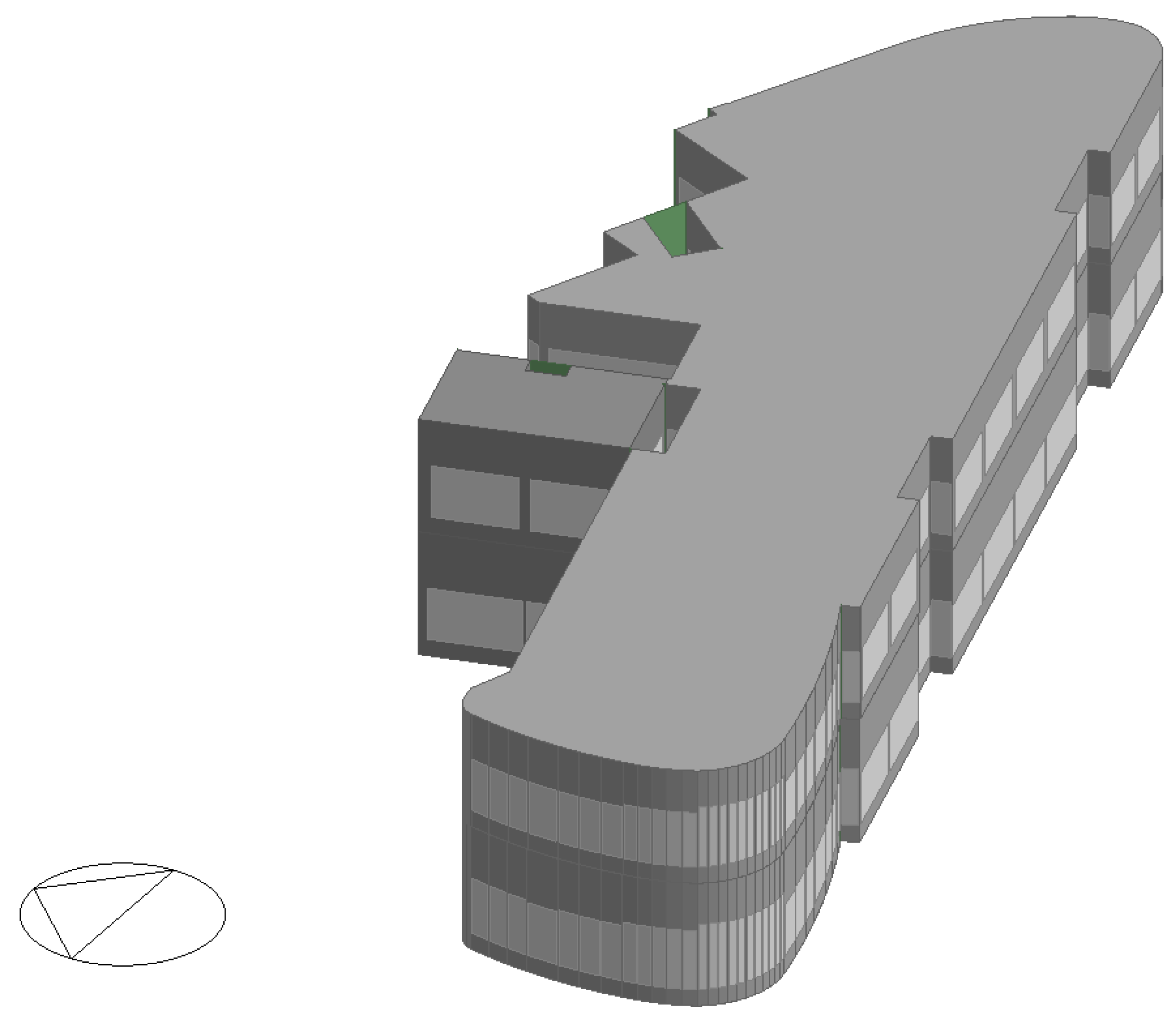
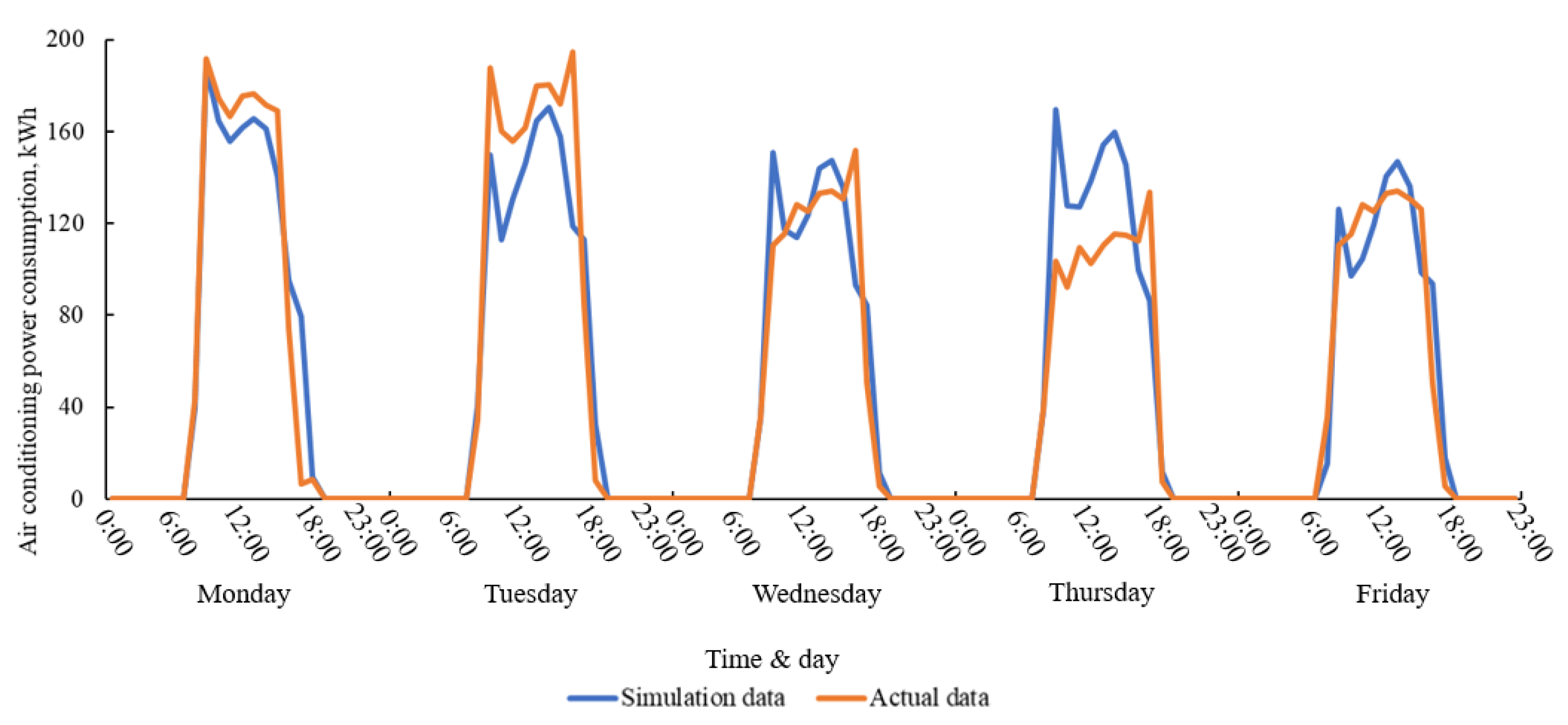
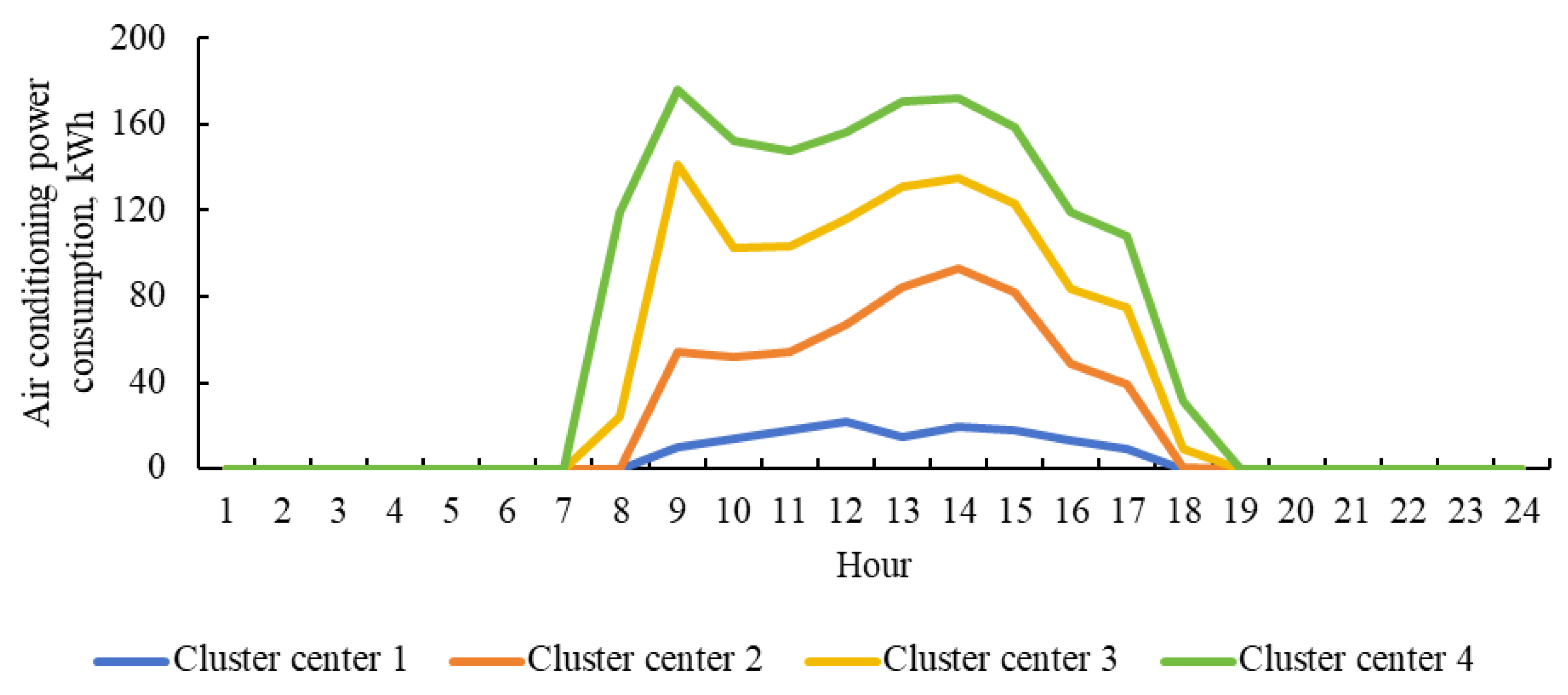
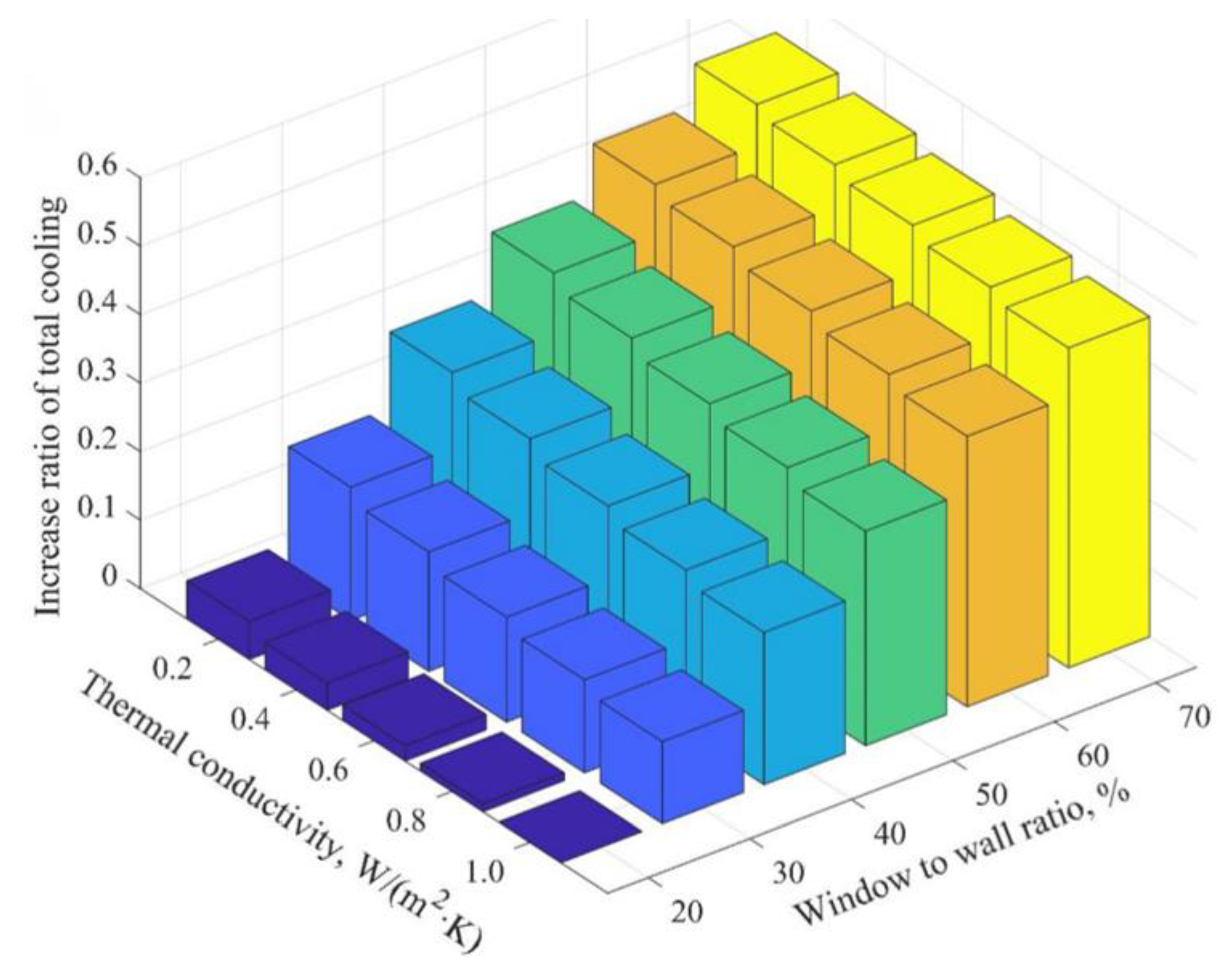

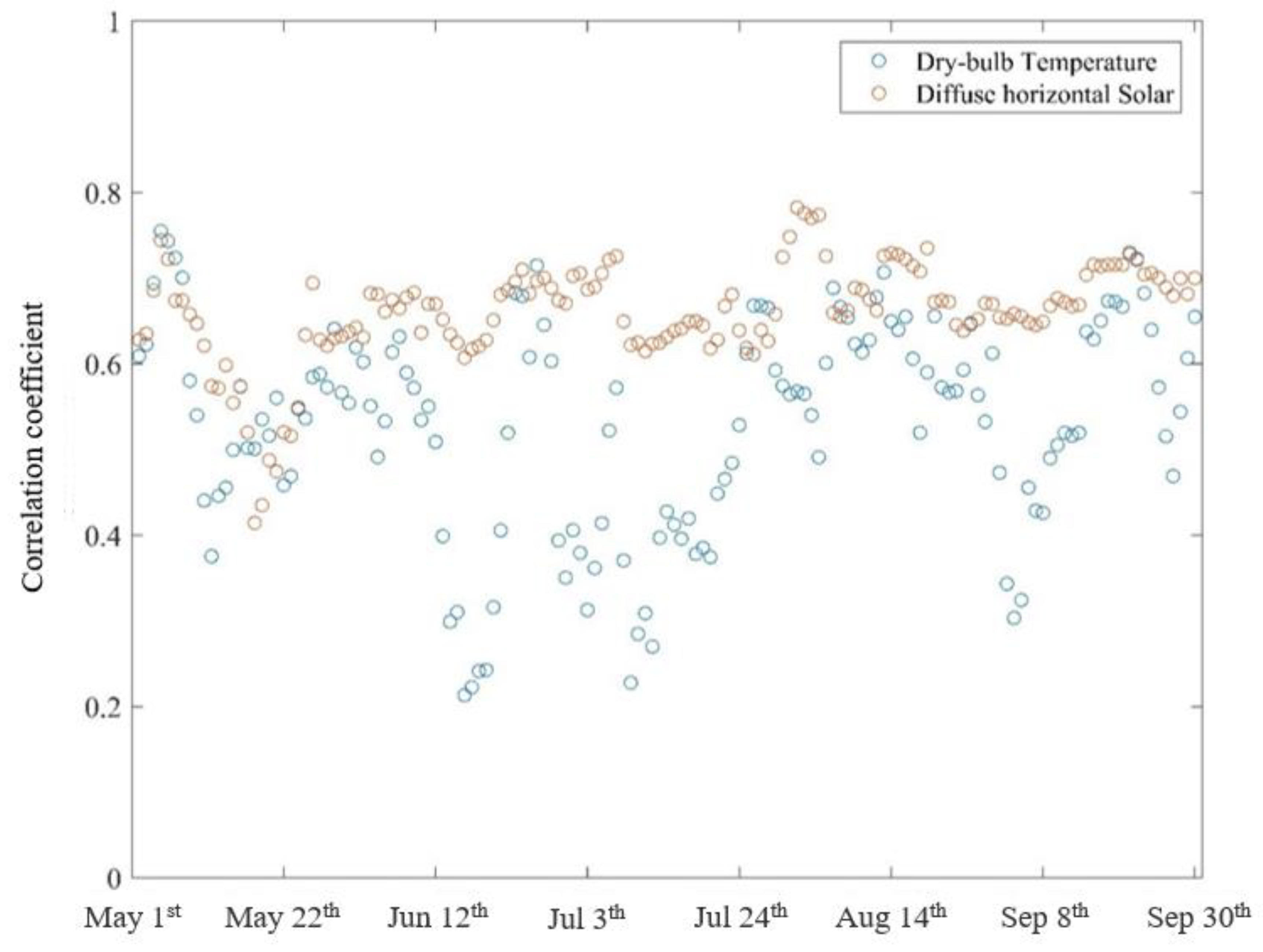

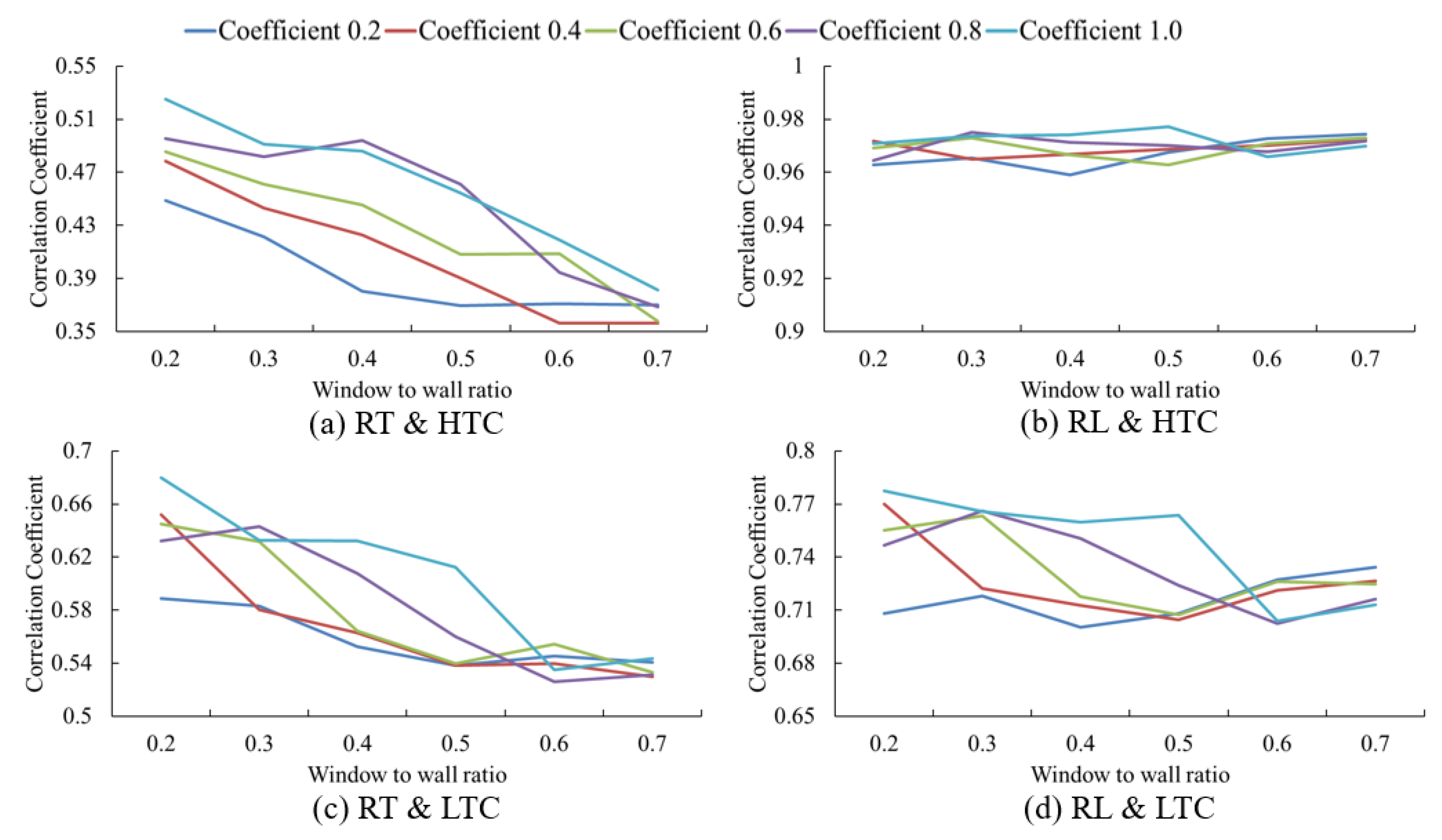


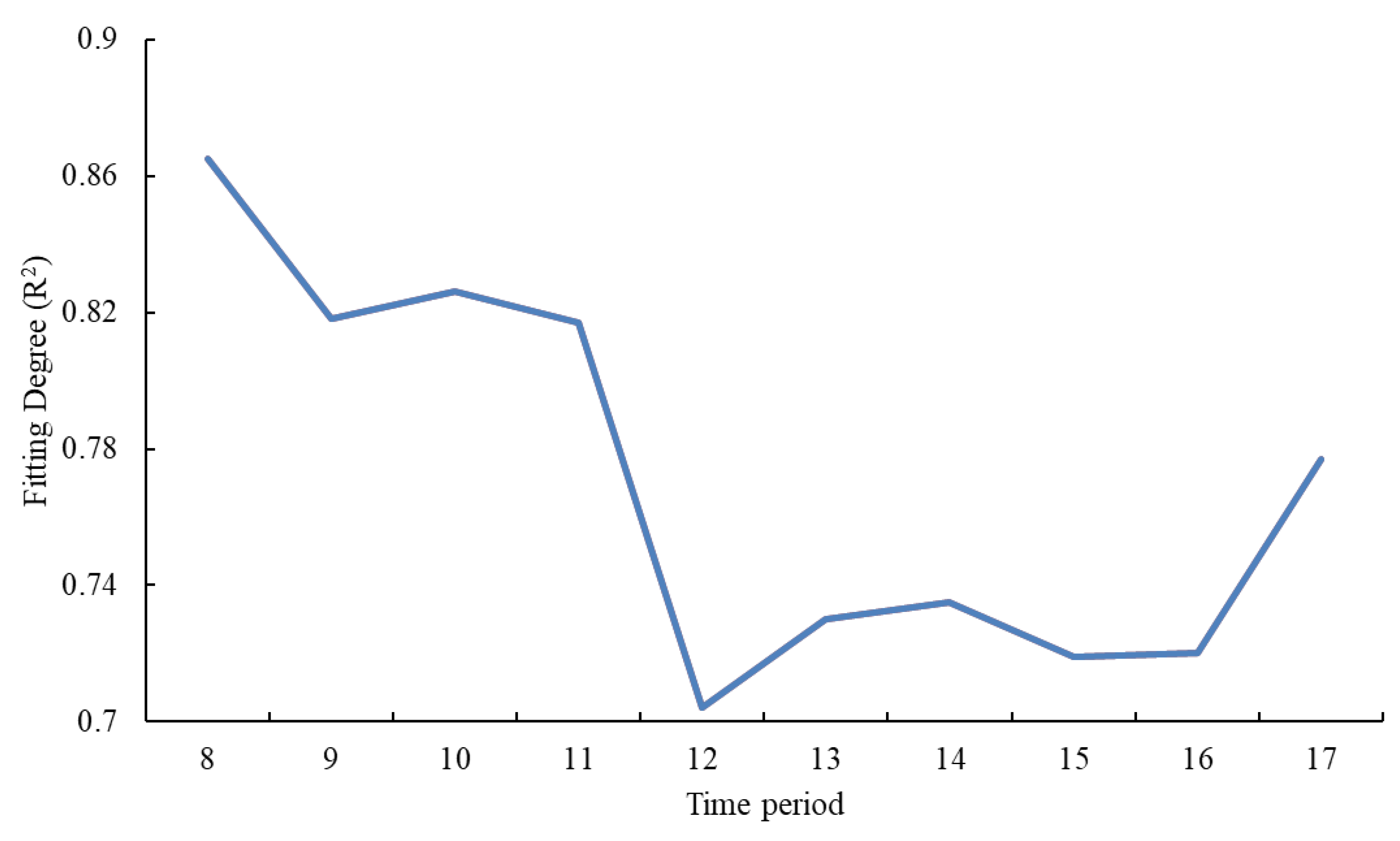
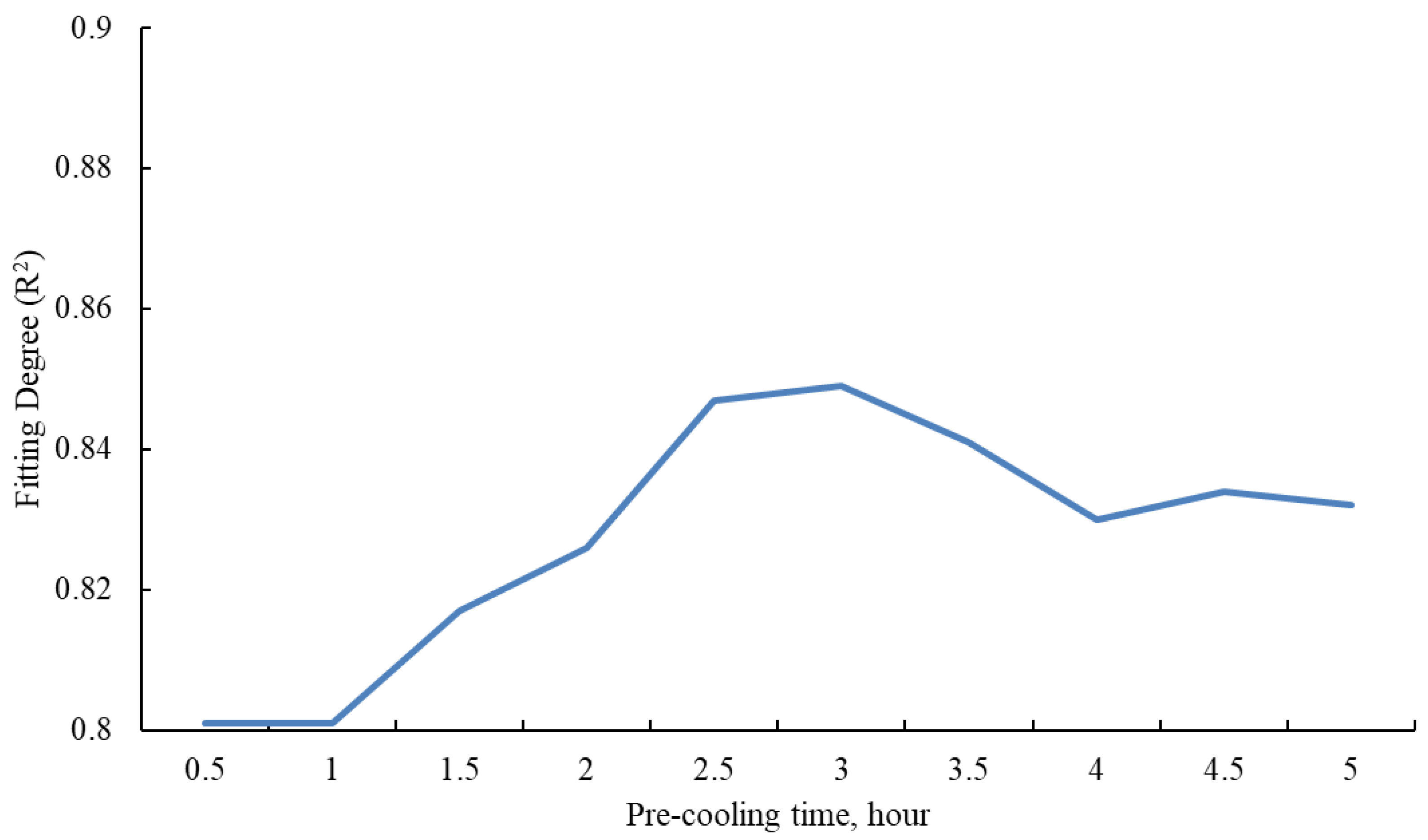
| Building Related Settings | |
| External wall heat transfer coefficient | 0.6 (0.2–1.0) (W/m2·K) |
| Roof heat transfer coefficient | 0.4 (W/m2·K) |
| Household wall, corridor wall heat transfer coefficient | 1.5 (W/m2·K) |
| Doors heat transfer coefficient | 2 (W/m2·K) |
| Windows heat transfer coefficient | 2 (W/m2·K) |
| Window to wall ratio | 0.5 (0.2–0.7) |
| Personnel density | 5 (m2/person) |
| Equipment heat dissipation | 12 (W/m2) |
| Air Conditioning System-Related Settings | |
| Air conditioning opening temperature | 28 °C |
| Air conditioning set temperature | 26 °C |
| Average annual COP of air conditioning system | 3.5 |
| Air conditioning system form | Chiller and fan coil unit |
Disclaimer/Publisher’s Note: The statements, opinions and data contained in all publications are solely those of the individual author(s) and contributor(s) and not of MDPI and/or the editor(s). MDPI and/or the editor(s) disclaim responsibility for any injury to people or property resulting from any ideas, methods, instructions or products referred to in the content. |
© 2025 by the authors. Licensee MDPI, Basel, Switzerland. This article is an open access article distributed under the terms and conditions of the Creative Commons Attribution (CC BY) license (https://creativecommons.org/licenses/by/4.0/).
Share and Cite
Yu, D.; Xu, T.; Jiang, Y.; Li, Q.; Qian, F. A Flexible Quantification Method for Buildings’ Air Conditioning Based on the Light and Heat Transfer Coefficients: A Case Study of a Shanghai Office Building. Energies 2025, 18, 1311. https://doi.org/10.3390/en18061311
Yu D, Xu T, Jiang Y, Li Q, Qian F. A Flexible Quantification Method for Buildings’ Air Conditioning Based on the Light and Heat Transfer Coefficients: A Case Study of a Shanghai Office Building. Energies. 2025; 18(6):1311. https://doi.org/10.3390/en18061311
Chicago/Turabian StyleYu, Dan, Tingting Xu, Yunxia Jiang, Qin Li, and Fanyue Qian. 2025. "A Flexible Quantification Method for Buildings’ Air Conditioning Based on the Light and Heat Transfer Coefficients: A Case Study of a Shanghai Office Building" Energies 18, no. 6: 1311. https://doi.org/10.3390/en18061311
APA StyleYu, D., Xu, T., Jiang, Y., Li, Q., & Qian, F. (2025). A Flexible Quantification Method for Buildings’ Air Conditioning Based on the Light and Heat Transfer Coefficients: A Case Study of a Shanghai Office Building. Energies, 18(6), 1311. https://doi.org/10.3390/en18061311









